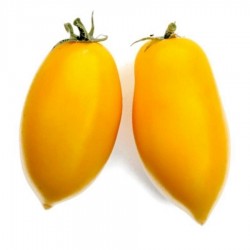Menu
-
Menuالعدمة
- Home
-
التصنيفات
-
-
التصنيفات
-
بذور الخضروات
-
أصناف حسب البلد
- أصناف من أرمينيا
- أصناف من البوسنة والهرسك
- أصناف من كرواتيا
- أصناف من فرنسا
- أصناف من ألمانيا
- أصناف من اليونان
- أصناف من المجر
- أصناف من الهند
- أصناف من إيطاليا
- أصناف من اليابان
- أصناف من شمال مقدونيا
- أصناف من بيرو
- أصناف من روسيا
- أصناف من صربيا
- أصناف من سلوفينيا
- أصناف من اسبانيا
- أصناف من تايلاند
- أصناف من تركيا
- أصناف من الولايات المتحدة الأمريكية
- بذور الطماطم
- بذور الذرة
- عائلة القرع
- الفول الأسرة
- بذور الخيار
- بذور الفلفل
- عائلة الجزرة
- عائلة البصل
- بذور الخس
- عائلة البطاطس
- عائلة الملفوف
- بذور الفجل
- عائلة الشمندر
- بذور البطيخ
- بذور بطيخ
- بذور القرنبيط
- عائلة عباد الشمس
-
أصناف حسب البلد
- بذور الفاكهة
- بذور الفلفل الحار
- بذور عشبة طبية
- تسلق بذور النباتات
- الأشجار - بذور بونساي
- بذور النخيل
- بذور الأعشاب الزينة
- بذور التبغ
-
بذور الخضروات
-
-
-
-
- منتجات جديدة
- التسليم - الدفع
- انشئ حساب
- FAQ
قائمة المنتجات من حيث العلامة التجارية Seeds Gallery
يوجد 408 منتجا.
عرض 397-408 من 408 منتجات

متنوعة من أمريكا
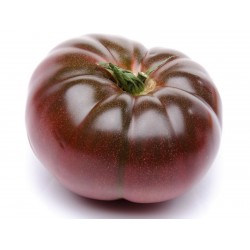
شيروكي بذور الطماطم الأرجواني
السعر
1.85 €
SKU: VT 24
Seeds Gallery Com,
5/
5
<h2><strong>شيروكي بذور الطماطم الأرجواني</strong></h2>
<h2><span style="color:#ff0000;"><strong>ثمن حزمة من 10 بذور.</strong></span></h2>
<p>Cherokee Purple هو اسم صنف من الطماطم يبتكر فاكهة بلون غامق وردة مع الحفاظ على لون أخضر مخضر إلى حد ما بالقرب من الساق عندما ينضج لتناول الطعام. يمنحها اللون القرمزي الداخلي والبشرة الواضحة لونها المميز. كانت واحدة من أوائل مجموعات الألوان الداكنة من الطماطم التي توصف أحيانًا باسم "السود" ؛ نشأت مجموعة Purple Calabash المتنوعة ، مع ثمارها غير المنتظمة للغاية ، في عدد قليل جدًا من كتالوجات البذور في منتصف القرن العشرين. كانت شركة Southern Exposure Seed Exchange أول شركة بذرة تقدم شركة Cherokee Purple والتي تم إصدارها بكميات محدودة في عام 1993.</p>
<p>الطماطم الشيروكي الأرجواني هي لحم البقر في الاسلوب. كما أنها ملحوظة لوجود قوام كثيف ومثير ، مع وجود بقع صغيرة من البذور منتشرة بشكل غير منتظم في جميع أنحاء اللحم. يتم تعزيز اللون الداخلي الداكن نسبيًا من خلال ميل البذور لتكون محاطة بالجيل الأخضر. في عام 1995 ، نشأت طفرة تشيروكي بيربل في لون البشرة في حديقة كريج لووليير في ولاية كارولينا الشمالية. سميت شوكوكي شوكولي ، والبشرة الصفراء تعطي الصنفرة صبغة الماهوغوني البنية. نشأت الشيروكي جرين في حديقة كريج في عام 1997 من زراعة الشوكولاته الشيروكي. إنه أحد الطماطم العديدة التي يظل لحمها أخضر عندما تنضج. لون البشرة أصفر ، والذي يوفر دليلًا للإشارة إلى متى تكون الطماطم ناضجة وجاهزة للحصاد.</p>
<p>الطماطم الشيروكي الأرجواني هي الأكثر شيوعًا في الصيف والخريف. من الأفضل الاستمتاع بهذه الطماطم الطازجة وغالبًا ما يتم استخدامها في شطائر وسلاطات BLT. يمكن استخدامه أيضًا عند صنع البيتزا والمعكرونة.</p>
<p>تلقى كريج لوولييه بذور طماطم أرجوانية لم يكشف عنها من جون د. جرين من سيفيرفيل بولاية تينيسي في عام 1990. وأشارت الرسالة المصاحبة إلى أصل شيروكي الهندي للطماطم في أواخر القرن التاسع عشر. بعد أن نمت الطماطم في حديقته عام 1991 ، مؤكدةً على تلوينها المستحضر الفريد والنظر في التاريخ المشترك بين السيد جرين ، قام كريج بتسمية مجموعة شيروكي بيربل وأرسلها إلى جيف ماكورماك من مركز تبادل البذور الجنوبي. استمتع جيف بطعم الطماطم وشركته أدرجت الصنف أولاً في كتالوج البذور لعام 1993. نمت شعبية وتوافر باطراد منذ ذلك الحين.</p>
VT 24


متنوعة من أمريكا
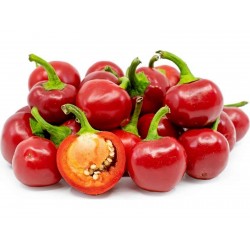
كرز أحمر كبير - بذور فلفل حار
السعر
1.65 €
SKU: C 46
Seeds Gallery Com,
5/
5
<h2 dir="rtl"><strong>كرز أحمر كبير - بذور فلفل حار</strong></h2>
<h2 dir="rtl"><span style="color: #ff0000;" class=""><strong>ثمن عبوة من 10 ، 50 بذرة.</strong></span></h2>
الفلفل الحار كبير الكرز الأحمر هو نوع زخرفي للغاية ، فواكه كبيرة (وزنها 20 إلى 50 جرامًا) ، تقريبًا مستدير بشكل صحيح ، ولونه أحمر جدًا. هذا الصنف يؤتي ثماره بأعداد كبيرة. تنضج الثمار بعد 60 إلى 75 يومًا. إنه ينتمي إلى الفلفل الحار المعتدل (حوالي 5000-35000 HSU).<br><br>تنوع استثنائي للتجفيف واستخدام الفلفل المطحون.<br><br>ينمو جيدًا في حقل مفتوح ، ودفيئة ، وفي قدر على الشرفة أو أي مكان آخر.<br><br>الفليفلة الحولية<br>بلد المنشأ: امريكا<script src="//cdn.public.n1ed.com/G3OMDFLT/widgets.js"></script>
C 46 (10 S)


Variation från Serbien
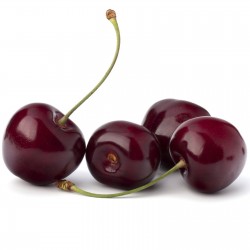
كرز حلو بذور (Prunus avium)
السعر
1.85 €
SKU: V 98
Seeds Gallery Com,
5/
5
<h2><strong>كرز حلو بذور (Prunus avium)</strong></h2>
<h2><span><strong><span style="color: #ff0000;">ثمن عبوة 10 بذور.</span></strong></span></h2>
<p>الكرز الحلو هو أحد أنواع جنس البرقوق من الفصيلة الوردية.</p>
<p>الموئل والانتشار<br>ينتشر في بلاد الشام وحوض البحر الأبيض المتوسط وتركيا والقوقاز والبلقان ومعظم أنحاء أوروبا.</p>
<p>Prunus avium, commonly called wild cherry,[1] sweet cherry,[1] bird cherry,[1] or gean,[1] is a species of cherry native to Europe, western Turkey, northwestern Africa, and western Asia, from the British Isles[2] south to Morocco and Tunisia, north to the Trondheimsfjord region in Norway and east to the Caucasus and northern Iran, with a small disjunct population in the western Himalaya.[3][4] This species, in the rose family (Rosaceae), has a diploid set of sixteen chromosomes (2n=16).[5] All parts of the plant except for the ripe fruit are slightly toxic, containing cyanogenic glycosides.</p>
<p><strong>Nomenclature</strong></p>
<p>The early history of its classification is somewhat confused. In the first edition of Species Plantarum (1753), Linnaeus treated it as only a variety, Prunus cerasus var. avium, citing Gaspard Bauhin's Pinax theatri botanici (1596) as a synonym;[clarification needed] his description, Cerasus racemosa hortensis ("Cherry with racemes, of gardens")[clarification needed] shows it was described from a cultivated plant.[6] Linnaeus then changed from a variety to a species Prunus avium in the second edition of his Flora Suecica in 1755.[7]</p>
<p>Sweet cherry was known historically as Gean or Mazzard (also 'massard'), until recently, both were largely obsolete names in modern English.</p>
<p>The name "wild cherry" is also commonly applied to other species of Prunus growing in their native habitats, particularly to the North American species Prunus serotina.</p>
<p>Prunus avium means "bird cherry" in the Latin language.[4] In English "bird cherry" often refers to Prunus padus.</p>
<p><strong>Mazzard</strong></p>
<p>More recently[when?] 'Mazzard' has been used to refer to a selected self-fertile cultivar that comes true from seed, and which is used as a seedling rootstock for fruiting cultivars.[9][10] This term is still used particularly for the varieties of P. avium grown in North Devon and cultivated there, particularly in the orchards at Landkey.</p>
<p><strong>Description and ecology</strong></p>
<p>Prunus avium is a deciduous tree growing to 15–32 m (50-100 ft) tall, with a trunk up to 1.5 m (5 ft) in diameter. Young trees show strong apical dominance with a straight trunk and symmetrical conical crown, becoming rounded to irregular on old trees. The bark is smooth purplish-brown with prominent horizontal grey-brown lenticels on young trees, becoming thick dark blackish-brown and fissured on old trees. The leaves are alternate, simple ovoid-acute, 7–14 cm (3–6 in) long and 4–7 cm (2–3 in) broad, glabrous matt or sub-shiny green above, variably finely downy beneath, with a serrated margin and an acuminate tip, with a green or reddish petiole 2–3.5 cm (0.8-1.4 in) long bearing two to five small red glands. The tip of each serrated edge of the leaves also bear small red glands.[11] In autumn, the leaves turn orange, pink or red before falling. The flowers are produced in early spring at the same time as the new leaves, borne in corymbs of two to six together, each flower pendent on a 2–5 cm (0.8-2 in) peduncle, 2.5–3.5 cm (1-1.4 in) in diameter, with five pure white petals, yellowish stamens, and a superior ovary; they are hermaphroditic, and pollinated by bees. The fruit is a drupe 1–2 cm (0.4-0.8 in) in diameter (larger in some cultivated selections), bright red to dark purple when mature in midsummer, edible, variably sweet to somewhat astringent and bitter to eat fresh. Each fruit contains a single hard-shelled stone 8–12 mm long, 7–10 mm wide and 6–8 mm thick, grooved along the flattest edge; the seed (kernel) inside the stone is 6–8 mm long.</p>
<p>The fruit are readily eaten by numerous kinds of birds and mammals, which digest the fruit flesh and disperse the seeds in their droppings. Some rodents, and a few birds (notably the Hawfinch), also crack open the stones to eat the kernel inside. All parts of the plant except for the ripe fruit are slightly toxic, containing cyanogenic glycosides.</p>
<p>See also List of Lepidoptera that feed on Prunus</p>
<p>The leaves provide food for some animals, including Lepidoptera such as the case-bearer moth Coleophora anatipennella.</p>
<p>The tree exudes a gum from wounds in the bark, by which it seals the wounds to exclude insects and fungal infections.</p>
<p><strong>Fruit</strong></p>
<p>Some eighteenth and nineteenth century botanical authors[who?] assumed a western Asia origin for the species based on the writings of Pliny; however, archaeological finds of seeds from prehistoric Europe contradict this view. Wild cherries have been an item of human food for several thousands of years. The stones have been found in deposits at Bronze Age settlements throughout Europe, including in Britain.[9] In one dated example, wild cherry macrofossils were found in a core sample from the detritus beneath a dwelling at an Early and Middle Bronze Age pile-dwelling site on and in the shore of a former lake at Desenzano del Garda or Lonato, near the southern shore of Lake Garda, Italy. The date is estimated at Early Bronze Age IA, carbon dated there to 2077 BC plus or minus 10 years. The natural forest was largely cleared at that time.[16]</p>
<p>By 800 BC, cherries were being actively cultivated in Asia Minor, and soon after in Greece.[9]</p>
<p>As the main ancestor of the cultivated cherry, the sweet cherry is one of the two cherry species which supply most of the world's commercial cultivars of edible cherry (the other is the sour cherry Prunus cerasus, mainly used for cooking; a few other species have had a very small input).[9] Various cherry cultivars are now grown worldwide wherever the climate is suitable; the number of cultivars is now very large.[9] The species has also escaped from cultivation and become naturalised in some temperate regions, including southwestern Canada, Japan, New Zealand, and the northeast and northwest of the United States.</p>
<p><strong>Ornamental</strong></p>
<p>It is often cultivated as a flowering tree. Because of the size of the tree, it is often used in parkland, and less often as a street or garden tree. The double-flowered form, 'Plena', is commonly found, rather than the wild single-flowered forms.</p>
<p>Two interspecific hybrids, P. x schmittii (P. avium x P. canescens) and P. x fontenesiana (P. avium x P. mahaleb) are also grown as ornamental trees.</p>
<p><strong>Timber</strong></p>
<p>The hard, reddish-brown wood (cherry wood) is valued as a hardwood for woodturning, and making cabinets and musical instruments.[15] Cherry wood is also used for smoking foods, particularly meats, in North America, as it lends a distinct and pleasant flavor to the product.[citation needed]</p>
<p><strong>Other uses</strong></p>
<p>The gum from bark wounds is aromatic and can be chewed as a substitute for chewing gum.</p>
<p>Medicine can be prepared from the stalks of the drupes that is astringent, antitussive, and diuretic.</p>
<p>A green dye can also be prepared from the plant.</p>
<p><strong>Contribution to other species</strong></p>
<p>Prunus avium is thought to be one of the parent species of Prunus cerasus (sour cherry) by way of ancient crosses between it and Prunus fruticosa (dwarf cherry) in the areas where the two species overlap. All three species can breed with each other. Prunus cerasus is now a species in its own right having developed beyond a hybrid and stabilised.</p><script src="//cdn.public.n1ed.com/G3OMDFLT/widgets.js"></script>
V 98 (2g)

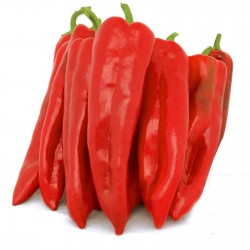
كورنو دي تورو روسو بذور الفلفل
السعر
1.75 €
SKU: PP 32
Seeds Gallery Com,
5/
5
<h2><strong>كورنو دي تورو روسو بذور الفلفل</strong></h2>
<h2><span style="color: #ff0000;"><strong>ثمن حزمة من 10 بذور.</strong></span></h2>
<p>كورنو دي تورو روسو ، Capsicum Annuum ، المعروف أيضا باسم Bull's Horn Chili. النبات ينمو إلى حوالي 1 متر في وعاء وهادئ سهل النمو.</p>
<p>كورنو دي تورو يعني قرن الثيران. القرون طويلة ، من 15 إلى 20 سم ، على شكل قرن ثور مدبب وهي الأكبر من حشوة الفلفل. هذه الجمالات الكبيرة اللذيذة واللذيذة منعشة ولذيذة أو تستخدم في التحميص والشواء ، وهي ممتازة للقلي أو السلطة أو الشواء. الفلفل الحار العظيم الكبير وهو حلو. يجب أن لجميع الحدائق.</p>
<p>نكهة الحكيمة: الحلو</p>
PP 32 (10 S)

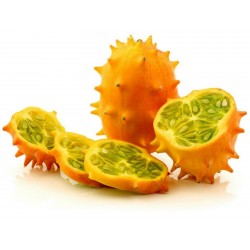
كيوانو بذور
السعر
2.00 €
SKU: PK 26
Seeds Gallery Com,
5/
5
<!DOCTYPE html>
<html>
<head>
<meta http-equiv="Content-Type" content="text/html; charset=UTF-8" />
</head>
<body>
<h2><strong>كيوانو بذور</strong></h2>
<h2><span style="color: #ff0000;"><strong>ثمن عبوة من 10 أو 25 بذرة.</strong></span></h2>
<p><strong>مثل كل عام ، قمنا بذر الكيوانو مرة أخرى هذا العام وقدمنا لك البذور الطازجة. نتمنى أن تستمتع بالطعم الغريب للكيوانو ...</strong></p>
<p>كيوانو أو الخيار المُقرن الأفريقي (باللاتينية: Cucumis metuliferus) فاكهة من فصيلة البطيخ، كانت تزرع في الأساس في أفريقيا، صفراء من الخارج ومليئة بالنتوءآت، ومن الداخل تتميز بلون أخضر وبذور متراصفة كما في الخيار. وبالنسبة للطعم فبالإمكان تشبيه الطعم بدرجة مُخففة من الموز غير الناضج.</p>
<p>كيوانو تُعتبر من الأطعمة النباتية التقليدية في أفريقيا، وهي قادرة على تحسِين التَغذية والأمّن الغِذائي، وتعزيز التنمية الريفيّة ودَعمّ الاستخدام المُستدام للأراضي. وهي واحدة من المصادر القليلة للمياه خلال موسم الجفاف في صحراء كالاهاري. في شمال زيمبابوي غاكا، وتُستخدم في المقام الأول كوجبة خفيفة أو سلطة، ونادراً للزينة. ويمكن أن تؤكل في أي مراحل النضوج، ولكن عندما تنضّج بشكل كامل سوف تنفجر بقوة لإطلاق البذور.</p>
<p>الإنتشار<br />نبات الكيوانو ينتشر بشكل شائع في أفريقيا جنوب الصحراء، كما تنمو في كاليفورنيا، مسيسيبي، تشيلي، أستراليا، نيوزيلندا، كما أنه ينبت في اليمن وله أسماء مختلفة من محافظة إلى أخرى، فمثلا في محافظة تعز يسمونه الحمك، وعادة ما يأكله الناس وهو ثمار صغيرة قبل أن تصل إلى اللون الأصفر</p>
<p>الإنبات<br />تنضُج بذور الكيوانو على درجات حرارة بين (20 - 35 درجة مئوية). يتوقف النمو عند درجات حرارة أقل من 12° وأعلى من 35°. لذلك يبدأ زراعة البذور بفصل الربيع عند بداية ارتفاع الحرارة فوق 15°.</p>
</body>
</html>
PK 26 (10 S)


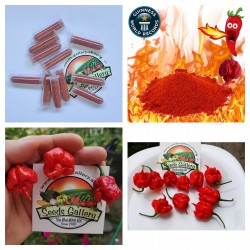
مسحوق Carolina Reaper في...
السعر
1.35 €
SKU: Z 5 CRPTT
Seeds Gallery Com,
5/
5
<h2 dir="rtl"><strong>مسحوق Carolina Reaper في أنبوب اختبار</strong></h2>
<h2 dir="rtl"><span style="color: #e03e2d;"><strong>1.8 جرام من المسحوق في أنبوب اختبار.</strong></span></h2>
<p dir="rtl"><strong>عملي جدًا للاستخدام ، يمكنك دائمًا تناوله معك وتتبيل الطبق بالطريقة التي تريدها :-)<br>مثل كل عام ، وفي هذا العام 2021 ، سيكون لدينا مرة أخرى 1200 من نباتاتنا التي نقدم لك منها البذور والأرضيات Carolina Reaper.<br></strong></p>
<p>Extremely spicy Carolina Reaper is great for meats, rubs, fish, soups, and much more! The small-sized packets are an excellent way to try out how spicy they are.</p>
<p>The Carolina Reaper, originally named the HP22BNH7, is a cultivar of chili pepper of the Capsicum chinense species. Bred in the Rock Hill, South Carolina greenhouse by Ed Currie, who runs the PuckerButt Pepper Company in Fort Mill, South Carolina, it has been rated as the world's hottest chili pepper by Guinness World Records since August 7, 2013. The original crossbreed was between a ghost pepper (a former world record holder) and a red habanero. The official Guinness World Record heat level is 1,569,300 Scoville Heat Units (SHU), according to tests conducted by Winthrop University in South Carolina.</p>
<p>At the second annual New York City Hot Sauce Expo on 30 March 2014, Ed Currie was presented with his world record by Guinness World Records and an eating competition was held in which the fastest time to consume three Carolina Reapers was determined for a new Guinness World Records at 12.23 seconds by Russel Todd. This record was beaten in September 2014 by Jason McNabb, who finished three peppers in 10.95 seconds.</p>
<script src="//cdn.public.n1ed.com/G3OMDFLT/widgets.js"></script>
Z 5 CRPTT


Variation från Peru
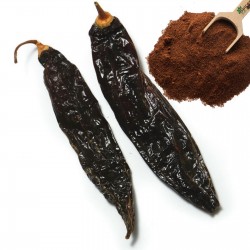
مسحوق أجي بانكا الفلفل...
السعر
1.65 €
SKU: Z 2 APP
Seeds Gallery Com,
5/
5
<h2 dir="rtl"><strong>مسحوق أجي بانكا الفلفل الأسود البيروفي</strong></h2>
<h2><span style="color: #f80000;"><strong>السعر 5 جرام من المسحوق.</strong></span></h2>
هناك العديد من الطرق التي يمكنك من خلالها استخدام Ají panca chili. اطبخيها في الحساء ، قطعيها وأضيفيها إلى السلطات أو استخدميها كطبق جانبي لأطباق اللحوم المختلفة. قائمة وصفات Ají panca الفلفل الحار تكاد لا تنتهي ، ويرجع ذلك أساسًا إلى أن هذه الخضروات تحظى بشعبية كبيرة في العديد من البلدان ويبتكر الطهاة دائمًا طرقًا مبتكرة لإعداد الفلفل الحار Ají panca.<br><br>تضع العديد من قوائم الطعام نباتي Ají panca الفلفل الحار ضمن أفضل عشرة نباتات ، ولكن هذه الخضار المغذية تستخدم أيضًا في العديد من الأطباق القائمة على اللحوم.<script src="//cdn.public.n1ed.com/G3OMDFLT/widgets.js"></script>
Z 2 APP (5g)

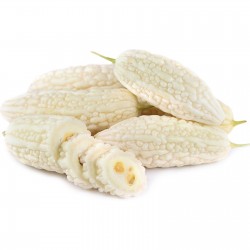
معضوضة كرمية الأوراق بذور...
السعر
6.50 €
SKU: V 7 B
Seeds Gallery Com,
5/
5
<h2 dir="rtl" class=""><strong>معضوضة كرمية الأوراق بذور (مومورديكا شارانتيا)</strong></h2>
<h2 dir="rtl"><span style="color: #fe0000;"><strong>سعر العبوة المكونة من 5 ، 10 ، 50 ، 100 بذرة.</strong></span></h2>
<div>
<p style="color: #202122; font-size: 15.2px;"><b>معضوضة كرمية الأوراق</b><span> </span>أو<span> </span><b>القرع المر</b><span> </span>(الاسم العلمي:<span> </span><span dir="ltr">Momordica charantia</span>) هي<span> </span>نوع<span> </span>من<span> </span>النباتات<span> </span>تتبع<span> </span>جنس<span> </span>المعضوضة<span> </span>من<span> </span>الفصيلة<span> </span>القرعية.<sup id="cite_ref-2" class="reference" style="font-size: 11px;">[2]</sup><span> </span>ونبات عشبي حولي زاحف يعرف شعبياً بعدة أسماء مثل الكمثرى البلسمية والخيار الكوري، بالإنجليزية معضوضة كرمية الأوراق ويعد هذا من النباتات المشهورة التي ثماره تشبه الكوسا أو الخيار ولكنه يبرز على سطحها الخارجي نتوءات كثيرة وتتميز بمذاقها المر.</p>
<p>If the Balsam Pear did not exist a pharmaceutical company would invent it. In fact, there have been some ten studies published this past year about it, the latest as of this writing in February 2008 in the Journal of Food Biochemistry about its potential in diabetes treatment.</p>
</div>
<div>A very common, bitter vegetable in Asian cuisine, the Balsam Pear, Momordica charantia, is a natural drug store for diabetics and others. It’s not a pear at all but a fruiting gourd and vine that smells like an old, well-used gym shoe. Don’t say you weren’t warned.</div>
<div>The warty gourd is edible when green (and cooked) but turns toxic when orange ripe. It then splits characteristically into three parts, revealing red arils (fleshy seed covers). The ripe seeds inside the arils and orange flesh of the gourd are toxic and can make one violently lose fluids from both ends, and induce abortions. The red arils around the seeds, however, are edible. And notice this: The arils are 96% lycopene, which gives them their color. Just remember to spit out the seed from each aril.</div>
<div>M. charantia is found Connecticut south to Florida, west to Texas, also Puerto Rico and the Hawaiian Islands. Incidentally, the bitter melon has twice the potassium of bananas and is also rich in vitamin A and C.</div>
<div> </div>
<div>The Latin genus name, Momordica, (mo-MOR-dee-ka) means “to bite,” and refers to the jagged edges of the leaves, which appear as if they have been bitten. Charantia (char-AN-tee-ah) the species’ name, comes from Greek meaning beautiful flower. It’s native to tropical regions of the world though no one knows where it came from originally. Gray’s four-inch thick Manual of Botany, started in 1850 and revised in 1950, makes no mention of M. charantia in the United States but it is currently a serious crop weed in Florida and to 21 other crops around the world, bananas to soybeans. It’s a late comer to Florida or Gray was in the dark about it. In the Amazon, and as far away as India, it is used very much by local populations for food and medicine. Apparently a dynamic chemical factory, the M. charantia is being tested for treatment against cancer — leukemia in particular — AIDS, as an analgesic, and to moderate insulin resistance. It is often called the vegetable insulin. It does not increase insulin secretion but “speeds up carbohydrate use of the cells by affecting membrane lipids.” Seems like the smelly gym shoe hanging on the fence has a great future. But, it is not for everyone: Don’t eat the vegetable if you’re hypoglycemic or pregnant. In diabetics it can lower blood sugar too effectively. It also reduces fertility in men and women. And, it contains vicine. That can cause favism in people who have a variant glucose-6-phosphate dehydrogenase. (I presume if you don’t know what that is you don’t have it. Favism is a severe reaction to fava beans and or their pollen. Occurs most often in Mediterranean men.)</div>
<div>Cultivated versions of the M. charantia, also called Bitter Gourd or Wild Balsam Apple, are found in most Asian markets, and they, too, smell like an old gym shoe. The odor, thankfully, almost all goes away when cooked and the bitterness moderates, but does not go away. If you are not yet brave enough to pick your own, you can buy some or grow it yourself. There are many varieties and numerous recipes are on the Internet. The M. charantia is indeed bitter. Some cut up the vegetable and soak it in water, or salted water and or blanch it to reduce the bitterness.</div>
<div>While I have never seen an Oriental family picking M. charantia off local fences here in Florida, I have seen many Hispanic families doing so. Dr. Julia Morton, a plant professor in south Florida, says besides the green fruit, the young leaves when cooked and drained are also edible and nutritious, with iron, phosphorous, calcium and vitamin C. I have never managed to get past the locker room bouquet to toss ‘em in a pot, and the fruit is just too bitter for me to enjoy. The ripe fruit pulp has been used as a soap substitute, which should give you some idea of the flavor. In India and Africa the cooked leaves are canned like spinach. The fragrant flowers can be used as seasoning when cooking.</div>
<div> </div>
<div>Incidentally, if you have a glut of green Bitter Gourds, you can slice them, partially boil them with salted water, then dry them, sun or otherwise. They will last for several months. You can then fry them and use as you like. Also, drinking the fresh bitter juice is recommended by some naturopaths. That ain’t going to be easy, it’s really bitter…. much easier to tell someone to do it than do it yourself.</div>
<div> </div>
<div>REMEMBER: No part of the Momordica charantia is ever to be eaten raw, except for the red arils (and remember to spit the seeds out.) No part, other than the arils, is ever to be eaten when ripe, which is when it is turning from green to yellow to orange. Do not eat the yellow or orange fruit raw or cooked. It is toxic. Also, the green fruit is suspected in the poisoning of dogs and pigs.</div>
<div> </div>
<div>Relatives: Momordica balsamina, which has longer spines on the fruit and can ripen to red, grows only in St. Lucie County in Florida and only a smattering of places in the southern U.S. M. balsamina fruit can be pickled or after soaking used as a cooked vegetable. Young shoots and tendrils are boiled as a green. The seeds are eaten. Momordica cochinchinensis produces a huge round fruit that is red when ripe. Young fruit boiled, not as bitter as M. charantia. Momordica dioica, small and roundish, is more esteemed than the rest. It is not bitter but sweet. Fruits, shoots, leaves and roots are boiled for food. There are also at least seven commercial cultivars of the Momordica gourds</div>
<div>IDENTIFICATION: Momordica charantia: A slender, climbing annual vine to 18 feet with long-stalked leaves and yellow flowers where the leaf meets the stem. Young fruit emerald green turning to orange when ripe. At maturity, fruit splits into three irregular parts that curl backwards showing many reddish-brown or white seeds encased in scarlet arils.</div>
<div> </div>
<div>TIME OF YEAR: Fruit, summer and fall in warm climates, fall in northern climes.</div>
<div> </div>
<div>ENVIRONMENT: Love to climb, found in hammocks, disturbed sites, turf and ornamental landscapes, and citrus groves . It seems to be the most common vine on chain link fences in Florida.</div>
<div> </div>
<div>METHOD OF PREPARATION: None of it ripe except the arils. Boiled green fruit (including seeds) leaves and shoots, boiled twice. Or, cut open and remove seeds and fiber and parboil. Ripe parts toxic are too bitter to eat. (An adult can swallow hole two ripe seed and not have much distress.) Young leaves and shoots are boiled and eaten as a potherb. Flowers used as seasoning.</div>
<div> </div>
<div>HERB BLURB</div>
<div>Herbalists say the charantia has long been used to treat diabetes and a host of other ailments from arthritis to jaundice.
<p> </p>
<table cellspacing="0" cellpadding="0" border="1">
<tbody>
<tr>
<td colspan="2" width="100%" valign="top">
<h3><span style="color: #008000;"><strong>Sowing Instructions</strong></span></h3>
</td>
</tr>
<tr>
<td valign="top" nowrap="nowrap">
<p><span style="color: #008000;"><strong>Propagation:</strong></span></p>
</td>
<td valign="top">
<p><span style="color: #008000;">Seeds</span></p>
</td>
</tr>
<tr>
<td valign="top" nowrap="nowrap">
<p><span style="color: #008000;"><strong>Pretreat:</strong></span></p>
</td>
<td valign="top">
<p><span style="color: #008000;">preswollen 2 days in water</span></p>
</td>
</tr>
<tr>
<td valign="top" nowrap="nowrap">
<p><span style="color: #008000;"><strong>Stratification:</strong></span></p>
</td>
<td valign="top">
<p><span style="color: #008000;">0</span></p>
</td>
</tr>
<tr>
<td valign="top" nowrap="nowrap">
<p><span style="color: #008000;"><strong>Sowing Time:</strong></span></p>
</td>
<td valign="top">
<p><span style="color: #008000;">all year round</span></p>
</td>
</tr>
<tr>
<td valign="top" nowrap="nowrap">
<p><span style="color: #008000;"><strong>Sowing Depth:</strong></span></p>
</td>
<td valign="top">
<p><span style="color: #008000;">0,5-1 cm</span></p>
</td>
</tr>
<tr>
<td valign="top" nowrap="nowrap">
<p><span style="color: #008000;"><strong>Sowing Mix:</strong></span></p>
</td>
<td valign="top">
<p><span style="color: #008000;">Coir or sowing mix + sand or perlite</span></p>
</td>
</tr>
<tr>
<td valign="top" nowrap="nowrap">
<p><span style="color: #008000;"><strong>Germination temperature:</strong></span></p>
</td>
<td valign="top">
<p><span style="color: #008000;">20 - 25° C</span></p>
</td>
</tr>
<tr>
<td valign="top" nowrap="nowrap">
<p><span style="color: #008000;"><strong>Location:</strong></span></p>
</td>
<td valign="top">
<p><span style="color: #008000;">bright + keep constantly moist not wet</span></p>
</td>
</tr>
<tr>
<td valign="top" nowrap="nowrap">
<p><span style="color: #008000;"><strong>Germination Time:</strong></span></p>
</td>
<td valign="top">
<p><span style="color: #008000;">1-4 weeks</span></p>
</td>
</tr>
<tr>
<td valign="top" nowrap="nowrap">
<p><span style="color: #008000;"><strong>Watering:</strong></span></p>
</td>
<td valign="top">
<p><span style="color: #008000;">Water regularly during the growing season</span></p>
</td>
</tr>
<tr>
<td valign="top" nowrap="nowrap">
<p><span style="color: #008000;"><strong> </strong></span></p>
</td>
<td valign="top">
<p><br><span style="color: #008000;">Seeds Gallery 05.11.2012.</span></p>
<div><span style="color: #008000;"> </span></div>
</td>
</tr>
</tbody>
</table>
</div>
<script src="//cdn.public.n1ed.com/G3OMDFLT/widgets.js"></script>
V 7 B


هذا النبات له ثمار عملاقة
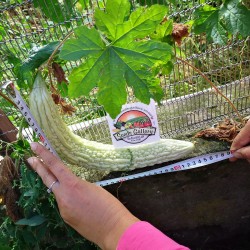
معضوضة كرمية الأوراق عملاق...
السعر
5.75 €
SKU: V 7 G
Seeds Gallery Com,
5/
5
<!DOCTYPE html>
<html>
<head>
<meta http-equiv="Content-Type" content="text/html; charset=UTF-8" />
</head>
<body>
<h2><strong>معضوضة كرمية الأوراق عملاق بذور</strong></h2>
<h2><span style="color: #ff0000;"><strong>ثمن حزمة من 5 بذور.</strong></span></h2>
<p>هذا أكبر شمام مر موجود ، يصل طوله إلى أكثر من 45 سم وعرضه 6 سم! بعد عدة سنوات ، تمكنا من استخراج أكبر قدر من الفاكهة وتخزينها وزرعها ، وأخيراً للعام الثالث على التوالي نحصل على نفس الثمار الضخمة حقًا!</p>
<p>معضوضة كرمية الأوراق أو القرع المر (الاسم العلمي: Momordica charantia) هي نوع من النباتات تتبع جنس المعضوضة من الفصيلة القرعية. ونبات عشبي حولي زاحف يعرف شعبياً بعدة أسماء مثل الكمثرى البلسمية والخيار الكوري، بالإنجليزية معضوضة كرمية الأوراق ويعد هذا من النباتات المشهورة التي ثماره تشبه الكوسا أو الخيار ولكنه يبرز على سطحها الخارجي نتوءات كثيرة وتتميز بمذاقها المر.</p>
<p>If the Balsam Pear did not exist a pharmaceutical company would invent it. In fact, there have been some ten studies published this past year about it, the latest as of this writing in February 2008 in the Journal of Food Biochemistry about its potential in diabetes treatment.</p>
<p>A very common, bitter vegetable in Asian cuisine, the Balsam Pear, Momordica charantia, is a natural drug store for diabetics and others. It’s not a pear at all but a fruiting gourd and vine that smells like an old, well-used gym shoe. Don’t say you weren’t warned.</p>
<div>The warty gourd is edible when green (and cooked) but turns toxic when orange ripe. It then splits characteristically into three parts, revealing red arils (fleshy seed covers). The ripe seeds inside the arils and orange flesh of the gourd are toxic and can make one violently lose fluids from both ends, and induce abortions. The red arils around the seeds, however, are edible. And notice this: The arils are 96% lycopene, which gives them their color. Just remember to spit out the seed from each aril.</div>
<div>M. charantia is found Connecticut south to Florida, west to Texas, also Puerto Rico and the Hawaiian Islands. Incidentally, the bitter melon has twice the potassium of bananas and is also rich in vitamin A and C.</div>
<div> </div>
<div>The Latin genus name, Momordica, (mo-MOR-dee-ka) means “to bite,” and refers to the jagged edges of the leaves, which appear as if they have been bitten. Charantia (char-AN-tee-ah) the species’ name, comes from Greek meaning beautiful flower. It’s native to tropical regions of the world though no one knows where it came from originally. Gray’s four-inch thick Manual of Botany, started in 1850 and revised in 1950, makes no mention of M. charantia in the United States but it is currently a serious crop weed in Florida and to 21 other crops around the world, bananas to soybeans. It’s a late comer to Florida or Gray was in the dark about it. In the Amazon, and as far away as India, it is used very much by local populations for food and medicine. Apparently a dynamic chemical factory, the M. charantia is being tested for treatment against cancer — leukemia in particular — AIDS, as an analgesic, and to moderate insulin resistance. It is often called the vegetable insulin. It does not increase insulin secretion but “speeds up carbohydrate use of the cells by affecting membrane lipids.” Seems like the smelly gym shoe hanging on the fence has a great future. But, it is not for everyone: Don’t eat the vegetable if you’re hypoglycemic or pregnant. In diabetics it can lower blood sugar too effectively. It also reduces fertility in men and women. And, it contains vicine. That can cause favism in people who have a variant glucose-6-phosphate dehydrogenase. (I presume if you don’t know what that is you don’t have it. Favism is a severe reaction to fava beans and or their pollen. Occurs most often in Mediterranean men.)</div>
<div>Cultivated versions of the M. charantia, also called Bitter Gourd or Wild Balsam Apple, are found in most Asian markets, and they, too, smell like an old gym shoe. The odor, thankfully, almost all goes away when cooked and the bitterness moderates, but does not go away. If you are not yet brave enough to pick your own, you can buy some or grow it yourself. There are many varieties and numerous recipes are on the Internet. The M. charantia is indeed bitter. Some cut up the vegetable and soak it in water, or salted water and or blanch it to reduce the bitterness.</div>
<div>While I have never seen an Oriental family picking M. charantia off local fences here in Florida, I have seen many Hispanic families doing so. Dr. Julia Morton, a plant professor in south Florida, says besides the green fruit, the young leaves when cooked and drained are also edible and nutritious, with iron, phosphorous, calcium and vitamin C. I have never managed to get past the locker room bouquet to toss ‘em in a pot, and the fruit is just too bitter for me to enjoy. The ripe fruit pulp has been used as a soap substitute, which should give you some idea of the flavor. In India and Africa the cooked leaves are canned like spinach. The fragrant flowers can be used as seasoning when cooking.</div>
<div> </div>
<div>Incidentally, if you have a glut of green Bitter Gourds, you can slice them, partially boil them with salted water, then dry them, sun or otherwise. They will last for several months. You can then fry them and use as you like. Also, drinking the fresh bitter juice is recommended by some naturopaths. That ain’t going to be easy, it’s really bitter…. much easier to tell someone to do it than do it yourself.</div>
<div> </div>
<div>REMEMBER: No part of the Momordica charantia is ever to be eaten raw, except for the red arils (and remember to spit the seeds out.) No part, other than the arils, is ever to be eaten when ripe, which is when it is turning from green to yellow to orange. Do not eat the yellow or orange fruit raw or cooked. It is toxic. Also, the green fruit is suspected in the poisoning of dogs and pigs.</div>
<div> </div>
<div>Relatives: Momordica balsamina, which has longer spines on the fruit and can ripen to red, grows only in St. Lucie County in Florida and only a smattering of places in the southern U.S. M. balsamina fruit can be pickled or after soaking used as a cooked vegetable. Young shoots and tendrils are boiled as a green. The seeds are eaten. Momordica cochinchinensis produces a huge round fruit that is red when ripe. Young fruit boiled, not as bitter as M. charantia. Momordica dioica, small and roundish, is more esteemed than the rest. It is not bitter but sweet. Fruits, shoots, leaves and roots are boiled for food. There are also at least seven commercial cultivars of the Momordica gourds</div>
<div>IDENTIFICATION: Momordica charantia: A slender, climbing annual vine to 18 feet with long-stalked leaves and yellow flowers where the leaf meets the stem. Young fruit emerald green turning to orange when ripe. At maturity, fruit splits into three irregular parts that curl backwards showing many reddish-brown or white seeds encased in scarlet arils.</div>
<div> </div>
<div>TIME OF YEAR: Fruit, summer and fall in warm climates, fall in northern climes.</div>
<div> </div>
<div>ENVIRONMENT: Love to climb, found in hammocks, disturbed sites, turf and ornamental landscapes, and citrus groves . It seems to be the most common vine on chain link fences in Florida.</div>
<div> </div>
<div>METHOD OF PREPARATION: None of it ripe except the arils. Boiled green fruit (including seeds) leaves and shoots, boiled twice. Or, cut open and remove seeds and fiber and parboil. Ripe parts toxic are too bitter to eat. (An adult can swallow hole two ripe seed and not have much distress.) Young leaves and shoots are boiled and eaten as a potherb. Flowers used as seasoning.</div>
<div> </div>
<div>HERB BLURB</div>
<div>Herbalists say the charantia has long been used to treat diabetes and a host of other ailments from arthritis to jaundice.
<p> </p>
<table cellspacing="0" cellpadding="0" border="1">
<tbody>
<tr>
<td colspan="2" width="100%" valign="top">
<h3><span style="color: #008000;"><strong>Sowing Instructions</strong></span></h3>
</td>
</tr>
<tr>
<td valign="top" nowrap="nowrap">
<p><span style="color: #008000;"><strong>Propagation:</strong></span></p>
</td>
<td valign="top">
<p><span style="color: #008000;">Seeds</span></p>
</td>
</tr>
<tr>
<td valign="top" nowrap="nowrap">
<p><span style="color: #008000;"><strong>Pretreat:</strong></span></p>
</td>
<td valign="top">
<p><span style="color: #008000;">preswollen 2 days in water</span></p>
</td>
</tr>
<tr>
<td valign="top" nowrap="nowrap">
<p><span style="color: #008000;"><strong>Stratification:</strong></span></p>
</td>
<td valign="top">
<p><span style="color: #008000;">0</span></p>
</td>
</tr>
<tr>
<td valign="top" nowrap="nowrap">
<p><span style="color: #008000;"><strong>Sowing Time:</strong></span></p>
</td>
<td valign="top">
<p><span style="color: #008000;">all year round</span></p>
</td>
</tr>
<tr>
<td valign="top" nowrap="nowrap">
<p><span style="color: #008000;"><strong>Sowing Depth:</strong></span></p>
</td>
<td valign="top">
<p><span style="color: #008000;">0,5-1 cm</span></p>
</td>
</tr>
<tr>
<td valign="top" nowrap="nowrap">
<p><span style="color: #008000;"><strong>Sowing Mix:</strong></span></p>
</td>
<td valign="top">
<p><span style="color: #008000;">Coir or sowing mix + sand or perlite</span></p>
</td>
</tr>
<tr>
<td valign="top" nowrap="nowrap">
<p><span style="color: #008000;"><strong>Germination temperature:</strong></span></p>
</td>
<td valign="top">
<p><span style="color: #008000;">20 - 25° C</span></p>
</td>
</tr>
<tr>
<td valign="top" nowrap="nowrap">
<p><span style="color: #008000;"><strong>Location:</strong></span></p>
</td>
<td valign="top">
<p><span style="color: #008000;">bright + keep constantly moist not wet</span></p>
</td>
</tr>
<tr>
<td valign="top" nowrap="nowrap">
<p><span style="color: #008000;"><strong>Germination Time:</strong></span></p>
</td>
<td valign="top">
<p><span style="color: #008000;">1-4 weeks</span></p>
</td>
</tr>
<tr>
<td valign="top" nowrap="nowrap">
<p><span style="color: #008000;"><strong>Watering:</strong></span></p>
</td>
<td valign="top">
<p><span style="color: #008000;">Water regularly during the growing season</span></p>
</td>
</tr>
<tr>
<td valign="top" nowrap="nowrap">
<p><span style="color: #008000;"><strong> </strong></span></p>
</td>
<td valign="top">
<p><br /><span style="color: #008000;">Seeds Gallery 05.11.2012.</span></p>
<div><span style="color: #008000;"> </span></div>
</td>
</tr>
</tbody>
</table>
</div>
</body>
</html>
V 7 G

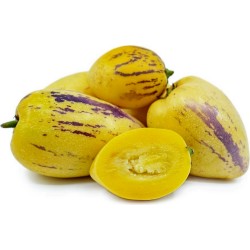
مغد خشن بذور
السعر
2.95 €
SKU: V 59
Seeds Gallery Com,
5/
5
<h2 class=""><strong>مغد خشن بذور</strong></h2>
<h3><span style="color: #ff0000;"><strong>ثمن حزمة من 5 بذور.</strong></span></h3>
<p>، تنتج ثمار قابلة للإستهلاك البشري. أزهاره بنفسجية اللون تظهر خلال فصل الربيع وأوائل الصيف. ثماره كروية إلى بيضاوية الشكل يصل وزنها إلى 01 كلغرام، خضراء اللون تتحول إلى الأصفر عند النضج. تستهلك طازجة أو كعصير و مربى.</p>
<p>الزراعة</p>
<p>زراعة القاشان سهلة حيث تتم زراعته عن طريق البذر في الربيع أو عن طريق العقل آخر فصل الصيف. و يحب نبات القاشان الأراضي الغنية جيدة الصرف، واحتياجاته من المياه متوسطة ما عدا في الصيف حيث يجب أن يسقى جيدا.</p>
<script src="//cdn.public.n1ed.com/G3OMDFLT/widgets.js"></script>
V 59 5S


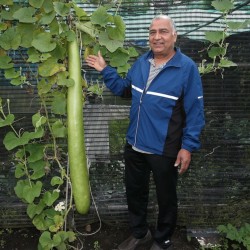
منذ فترة طويلة زجاجة بذور...
السعر
4.50 €
SKU: VG 34
Seeds Gallery Com,
5/
5
<meta http-equiv="Content-Type" content="text/html; charset=UTF-8" />
<h2><strong>منذ فترة طويلة زجاجة بذور القرع</strong></h2>
<h2><span style="color: #ff0000;"><strong>ثمن عبوة 5 بذور.</strong></span></h2>
<p>الثمار أسطوانية بطول 60-150 سم ويمكن أن يصل وزنها إلى 2.5 كجم. ويقال أن اللحم الأبيض الكريمي له نكهة وملمس شبيه بالفاصوليا الخضراء.</p>
<p>اختر الفاكهة الخضراء عندما تكون صغيرة ، طولها 15-60 سم.</p>
<p>القرع الطويل (Lagenaria siceraria provar. turbinata)</p>
VG 34 (5 S)


